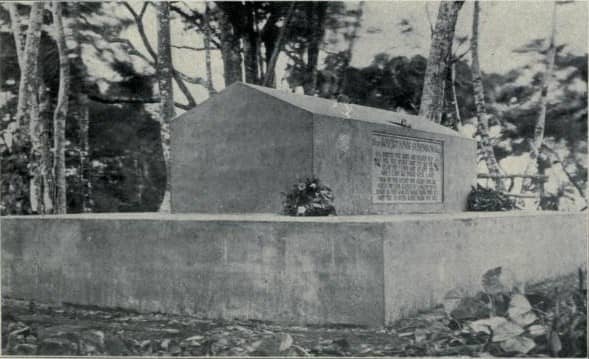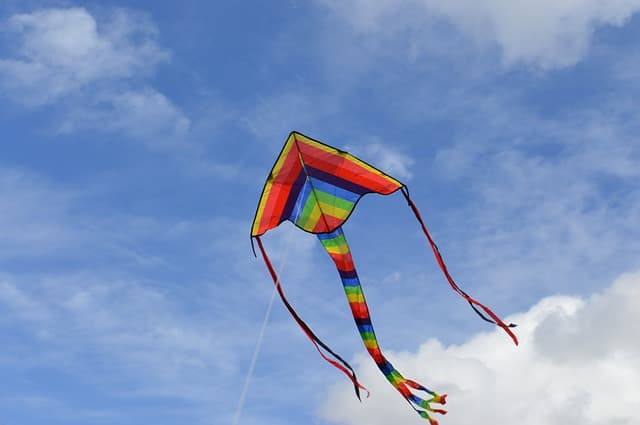From a Railway Carriage by Robert Louis Stevenson
“From a Railway Carriage” is the 37th poem (XXXVII) of Robert Louis Stevenson’s A Child’s Garden of Verses (1885), occurring just before “Winter-Time,” another lovely poem meant for children. This poem captures the world outside a moving train, sliding past a child’s eyes filled with excitement. The cinematic shots echo the constant rhythm and speed of the locomotive. Each scene swipes past, and a child from a 19th-century railway carriage exclaims: “Each a glimpse and gone for ever!” It’s the magic of traveling by train—each journey unfolds unique experiences that stick to our minds forever.
- Read the full poem “From a Railway Carriage” below:
From a Railway Carriage by Robert Louis Stevenson Faster than fairies, faster than witches, Bridges and houses, hedges and ditches; And charging along like troops in a battle, All through the meadows the horses and cattle: All of the sights of the hill and the plain Fly as thick as driving rain; And ever again, in the wink of an eye, Painted stations whistle by. Here is a child who clambers and scrambles, All by himself and gathering brambles; Here is a tramp who stands and gazes; And there is the green for stringing the daisies! Here is a cart run away in the road Lumping along with man and load; And here is a mill and there is a river: Each a glimpse and gone for ever! - from A Child’s Garden of Verses (1885)

Vocabulary & Word Meaning
Explore the vocabulary of “From a Railway Carriage” and learn the meaning of the words:
- Hedge (line 2): a boundary formed by closely growing bushes or shrubs
- Ditches (line 2): narrow channels in the ground for drainage alongside fields
- Clamber (line 9): to climb out of something using both hands and feet with difficulty
- Scramble (line 9): to make way over rough ground by using hands and feet hurriedly
- Brambles (line 10): prickly vines or wild shrubs
- Tramp (line 11): a homeless vagrant, vagabond, or beggar
- Stringing (line 12): arranging something in a string
- Lumping (line 14): bearing a heavy burden from one place to another
- Glimpse (line 16): a sudden flash of a scene or sudden look
Summary
Stevenson’s “From a Railway Carriage” is written from the perspective of a child who is traveling by train and capturing the external world from his carriage. He is quite amazed to experience the speed with which the train marches forward like troops in a battle. It moves faster than the fairies and witches collectively. From his carriage, he sees how the sights of the hill and plain fly past. The painted stations whistle by in a wink.
In the second stanza, the speaker becomes more attentive to the scenes outside. He notices a child gathering brambles with difficulty, a tramp standing and gazing back at him with his vacant eyes, the greenery cuddling the bright daisies. Furthermore, there is a loaded cart lumping along the road, a mill, and a river that goes past the carriage within a glimpse.
Meaning
The title of the poem “From a Railway Carriage” gives a hint to the subject matter that is about the scenes one witnesses sitting in a moving railway carriage. Stevenson’s speaker, a child with his eager eyes, drinks each scene as if it did not occur to him before. The outside world rushing past his carriage is more interesting than fairy tales and faster than their characters. As the train marches forward, he focuses on each and everything that moves backward. The poem does not come to a halt. It starts with the rhythm of the train and ends with its ceaseless flow. The carriage of Stevenson’s poem does not stop as readers continue the journey along with the speaker when his narration ends.
Form, Rhyme Scheme, & Meter
Structure & Form
“From a Railway Carriage” is a lyric poem written from the perspective of a child who is traveling by train. Stevenson uses the third-person narrative technique in order to describe the journey. The presence of the third-person speaker narrating his experience can be understood by the line, “Here is a child who clambers and scrambles.” This line contains the showing technique and encourages readers to imagine what the narrator is witnessing. Besides, the presence of a regular rhyme scheme and meter creates a sing-song-like rhythm in the text.
Rhyme Scheme
The rhyme scheme of “From a Railway Carriage” is AABB. It means each two lines end with similar rhyming words; for instance, the first two lines contain end rhymes: “witches” and “ditches”. This scheme is followed throughout the text. The rhyming pairs of words include:
- Lines 3-4: “battle” and “cattle”
- Lines 5-6: “plain” and “rain”
- Lines 7-8: “eye” and “by”
- Lines 9-10: “scrambles” and “brambles”
- Lines 11-12: “gazes” and “daisies” (pronounce “gazes” as “geiziz”)
- Lines 13-14: “road” and “load”
- Lines 15-16: “river” and “ever”
Meter
The poem is written in iambic tetrameter with a number of variations. Each line more or less contains four iambs; an unstressed foot is followed by a stressed foot. The implementation of trochees (stressed-unstressed) and long anapests (unstressed-unstressed-stresses) imitates the rising and falling rhythm of a train. For instance, the first line can be read as “Fast-er/ than fai-ries,/ fast-er/ than witch(e)s.” It begins with a trochee followed by an anapest. Then another trochee is followed by an iamb. This fusion of can be seen throughout the text:
Fast-er/ than fai-ries,/ fast-er/ than witch(e)s,
Bridg-es/ and hous/-es, hedg/-es and ditch(e)s;
And charg/-ing a-long/ like troops/ in a battle,
All through/ the mea/-dows the hors/-es and cattle:
All/ of the sights/ of the hill/ and the plain
Fly/ as thick/ as driv/-ing rain;
And e/-ver a-gain,/ in the wink/ of an eye,
Paint-ed/ sta-tions/ whistle by.
Here/ is a child/ who clamb/-ers and scrambl(e)s,
All by/ him-self/ and gath(e)/-ring brambles;
Here is/ a tramp/ who stands/ and gaz(e)s;
And there/ is the green/ for string/-ing the dais(ie)s!
Here is/ a cart/ run a-way/ in the road
Lump-ing/ a-long/ with man/ and load;
And here/ is a mill/ and there/ is a riv(e)r:
Each/ a glimpse/ and gone/ for e-ver!
Poetic Devices & Figures of Speech
Stevenson uses a number of poetic devices to depict the movement of the train. The important figures of speech used in the poem are exemplified below:
Simile
The poem “From a Railway Carriage” begins with a simile: “Faster than fairies” and “faster than witches.” Stevenson describes how the fairies and witches are not as fast as the train. This device is also used in lines 3 and 6:
- “And charging along like troops in a battle”
- “Fly as thick as driving rain”
In the first example, the moving train is compared to troops marching for a battle, and the sights of apparently moving “hill” and “plain” are compared to “driving rain.”
Metaphor
Stevenson uses several personal metaphors in the poem. For instance, there is a personal metaphor in the phrase, “the green for stringing the daisies!” The “green,” representing grass, is portrayed as a thread to string daisies. To be specific, there is only one instance of metaphor, and it occurs in the last two lines:
And here is a mill and there is a river:
Each a glimpse and gone for ever!
The “mill” and “river” are compared to a “glimpse”. They are liked small clips of the motion picture seen from the railway carriage.
Alliteration
The repetition of a similar sound at the beginning of neighboring words is called alliteration. It is used to create internal rhyming. This device is used in the following instances:
- “Faster than fairies, faster” (line 1)
- “houses, hedges” (line 2)
- “glimpse and gone” (line 16)
Apart from that, readers can also find the use of consonance, the repetition of consonant sounds in closely placed words. For instance, there is a repetition of the “z” sound at the end of “fairies,” “witches,” “Bridges,” “houses,” “hedges,” and “ditches” in lines 1 and 2.
Personification
In “Painted stations whistle by,” the stations are personified. The poet invests them with the ability of whistling. It is actually the rail personnel who whistle when the train crosses each station. In the second stanza, the “cart” is personified and depicted as lumping with man and load.
Anaphora
The repetition of the same word or phrase at the beginning of consecutive lines is called anaphora. It occurs in:
All through the meadows the horses and cattle:
All of the sights of the hill and the plain
Repetition
This device is used in a number of instances; in the first stanza, there is a repetition of “and” throughout. Such repetition is also called polysyndeton. The recurrence of the conjunction signifies a sense of continuity. In the second stanza, Stevenson uses the word “Here” at the beginning of alternative lines until line 5.
Rhetorical Exclamation
This device is used in two instances in the last stanza: “And there is the green for stringing the daisies!” and “Each a glimpse and gone for ever!” These lines convey the speaker’s amazement at the scenes.
Line-by-Line Explanation & Analysis
Lines 1-4
Faster than fairies, faster than witches,
Bridges and houses, hedges and ditches;
And charging along like troops in a battle,
All through the meadows the horses and cattle:
Robert Louis Stevenson’s poem “From a Railway Carriage” begins with the description of the train’s speed. The reference to “fairies” and “witches” signifies the speaker is a child, familiar with the characters of fairy tales. He rejects the fact quite straightforwardly that this train he is riding is way faster than the winged fairies and magical witches.
According to the speaker, the train is not faster than them. Instead, the bridges, houses, hedges, and ditches, that move past his carriage showcase such swiftness. In the following line, he metaphorically describes the train as an army marching forward for a battle. The preparedness of the troops and their unhindered motion is comparable to that of the train. From the carriage, he can notice the horses and cattle grazing through the meadows.
Lines 5-8
All of the sights of the hill and the plain
Fly as thick as driving rain;
And ever again, in the wink of an eye,
Painted stations whistle by.
The speaker further adds the sights or visual images of the hill and the plain that he notices from his carriage. Everything noticeable from his coach is so swift that he cannot differentiate one scene from another. He describes the collective scene through the image of heavy rain.
In the last two lines of the first stanza, the speaker informs readers that he has been riding before the narration has begun. Thus, the painted stations “again” slid past his carriage. Stevenson uses an auditory image of the whistling sound coming from the stations when the train crosses them.
Lines 9-12
Here is a child who clambers and scrambles,
All by himself and gathering brambles;
Here is a tramp who stands and gazes;
And there is the green for stringing the daisies!
In the second stanza, the speaker of “From a Railway Carriage” becomes specific about what he witnesses from the moving train. He points at a child clambering and scrambling alone to gather brambles. There is a homeless tramp whose vacant look grasps his attention. The man just stands and gazes at the fast locomotive in awe. Then quickly, the scene shifts to the green fields where daisies nod their heads. The speaker describes each daisy strung to the thread of greenery, an impressive image.
Lines 13-16
Here is a cart run away in the road
Lumping along with man and load;
And here is a mill and there is a river:
Each a glimpse and gone for ever!
The last four lines continue in a similar fashion. There is a loaded cart running behind. It moves in an awkward way due to the weight of the man and load. Furthermore, there is a mill and a river that the speaker notices from the train.
At last, the speaker describes each piece of scenery as a “glimpse” that stays for a short period and then fades forever. While traveling by train, none can notice a particular scene next time. Thus, each journey becomes unique, unraveling newer scenes against the changing canvas of nature.
Theme
Stevenson’s “From a Railway Carriage” explores the theme of a train journey. The main narrative runs on the basis of the scenes captured from a moving train through the eyes of a child. Each scene is depicted as it unfolds in front of his eyes. The bridges and houses, hedges and ditches all move in the opposite direction to the moving train swiftly. Throughout the piece, the speaker goes on to describe each prominent figure/scene that captures his attention. In the second stanza, he becomes particular about the child, tramp, and cart and spends a line or two describing their activities. Overall, the poem resonates with the rhythm and speed of a locomotive rushing through long distances.
Tone & Mood
The tone of “From a Railway Carriage” is filled with a child’s excitement during a train journey. His voice is filled with amazement, joy, and curiosity, as evident in any child while traveling by train. The repetition of “and” in the first stanza displays his excitement at the scenes. In the second stanza, his tone reflects a sense of curiosity as he describes a child, tramp, and loaded cart. Overall, the mood of the poem is lighthearted, spirited, and joyous. It fills readers’ hearts (especially children’s) with awe and amazement.
Use of Images
Stevenson employs visual and kinesthetic imagery in the first stanza. He visually depicts the scene that the speaker witnesses from his carriage. Through kinesthetic images, he describes the apparent motion of bridges, houses, hedges, etc. The last line of the first stanza, “Painted stations whistle by,” contains auditory imagery. This line refers to the whistle’s sound coming from the station when the train crosses it. The second stanza also contains similar imagery. As the train moves hurriedly, the speaker cannot hear the sound of others outside or hear the smell of daisies. He can only capture their acts when the train moves past them. Besides, Stevenson uses organic imagery in lines 12 and 16 to convey the speaker’s inner feelings of joy and wonder.
Historical Context
The poem “From a Railway Carriage” was first published in Robert Louis Stevenson’s collection of children’s poetry, A Child’s Garden of Verses, in 1885. It is one of the most popular children’s works. This poem is inspired by Stevenson’s extensive traveling experience across Europe. Due to his ill health, he occasionally had to move to warmer climates to recover. His experience of traveling by train is captured in this poem from the perspective of a child speaker. This piece also describes how it felt while traveling in a railway carriage car in the 19th-century.
Questions and Answers
“From a Railway Carriage” by Robert Louis Stevenson is written from the perspective of a child who is traveling by train during the daytime. He narrates what he witnesses from his carriage, including the bridges, houses, hedges, ditches, meadows, hill, plain, etc. In the first stanza, he describes how swiftly the train moves and the scenes slide past him. In the second stanza, he specifically talks about a child struggling to gather brambles, a tramp gazing at the train, and a loaded cart lumping on the road. The tone of the speaker is similar to the narrators of Stevenson’s poems “Windy Nights” and “Winter-Time.”
Indeed, “From a Railway Carriage” is a narrative poem. This poem is about a child speaker’s experience of traveling by a railway carriage. He describes all the scenes he witnesses from his car and goes on to narrate how they move past swiftly. Furthermore, he takes notice of other characters, such as a child, a tramp, and a man driving a cart. He describes their activities while his train moves past them. Stevenson employs the third-person (or omniscient) narrative technique to describe the child’s experience of the train journey. This piece can be compared with Stevenson’s another narrative poem from A Child’s Garden of Verses(1885), “The Wind.”
In Stevenson’s poem “From a Railway Carriage,” the train moves through a village or rural landscape. This argument can be justified from the explicit references to the rural scenes. For instance, in the second line, the speaker describes how the train moves past “hedges” and “ditches”; in the fourth line, he says how the “horses and cattle” graze over the meadows; in the fifth line, he notes the “hill” and “plain”. Such scenes can only be noticed if the train goes past city limits and rushes through the rural landscape.
As the poem progresses to the second stanza, it seems the train is passing through human settlements. The presence of human figures can only be noticed in the second stanza. In the ending lines, the train comes closer to the city as readers can locate a mill and a river nearby. It has not entered the city yet, but within a moment, it would.
In 1884, Robert Louis Stevenson settled in the Westbourne district of Bournemouth, in Dorset, England, after his frequent travels to Scotland and across Europe. He was largely bedridden due to his chronic bronchial trouble. Despite his illness, he continued writing for his three years’ stay in Westbourne. It was at that time he penned down his most famous works. One of them is The Child’s Garden of Verses, which was published in 1885. Therefore, the poem “From a Railway Carriage” was written somewhere between 1884 to 1885.
The important poetic devices used in the poem include simile, metaphor, alliteration, consonance, personification, anaphora, repetition, rhetorical exclamation, etc.
Stevenson’s “From a Railway Carriage” is a narrative poem that is written from the perspective of a child-speaker. It is in the third-person point of view. There are two eight-line stanzas. The rhyme scheme of the poem is AABB, and it is mostly composed in iambic tetrameter.
The message of the poem is that each journey is different. One needs to be interested and curious like a child to appreciate the scenes unfolding while traveling through remote regions. The main message lies in the line of the poem, “Each a glimpse and gone for ever!” The presence of an exclamation mark at the end hints at the speaker’s sense of amazement at the fact that the scenes stay for a short period. We need to be flexible enough to be content with just a “glimpse” like the speaker and should not desire for more.
The central idea of the poem revolves around a speaker’s sense of awe and amazement at the scenes seen from a railway carriage. This poem captures what he witnesses from his carriage. Each scene is like a “glimpse” that is unique and temporary. So, one needs to be attentive enough to watch such wonderful scenes.
Stevenson brings out the rhythm of the locomotive through the alternating meter and regular rhyme scheme. The usage of internal rhymes also serves this purpose. For instance, the first two lines start with the falling rhythm of the trochees. Then the rhythm rises and then again falls, imitating the quick tempo of the locomotive rhythm.
The “Railway Carriage” in British usage is a passenger car of a train. Stevenson uses this phrase in this sense.
In the first lines, Stevenson indirectly describes the train’s fast pace through the moving bridges and houses, hedges, and ditches. He says these things move faster than “fairies” and “witches.” Fairy is a tiny, imaginary, winged creature with magical powers. A witch is a woman with evil magical powers, depicted as wearing a black cloak, pointed hat, and flying in a broomstick.
The speaker of “From a Railway Carriage” could only mention these things as the train moved too fast to notice each scene perfectly. That’s why he uses the plural form of each of these nouns to say he saw each of them in abundance.
The “sights” rapidly move past the speaker while he is sitting in the railway carriage. That’s why it seems the scenes are flying away.
The poet compares the things he sees to “driving rain” for their viewability. He can only have a glimpse of each thing. The scenes are as hazy as seeing something in heavy rain.
The child clambers and scrambles as he gathers brambles.
The “green” represents the greenery or grass that embraces the daisies. It seems the greenery is a thread stringing the daisies as precious gems.
The phrase “stringing the daisies” means arranging the daisies in a string. In the poem, the “green” or greenery is seen to string the daisies.
As the train is rushing through the landscape, he can only have a glimpse of the mill and the river.
Each scene slides past the poet so fast that he cannot notice each one of them totally. That’s why he says that the things he sees are like a momentary glimpse or clips of a motion picture.
Similar Poems about Journeys
- “Night Journey” by Theodore Roethke — Read how it feels while traveling by train at midnight. Roethke beautifully describes the nocturnal beauty of nature in this poem.
- “Journey to the Interior” by Margaret Atwood — In this poem, Atwood describes the road she often takes to roam into the thrilling regions of her mind.
- “Up-Hill” by Christina Rossetti — It’s one of the best-loved poems of Christina Rossetti that describes one speaker’s hesitations on the uphill journey of life.
- “Across the Border” by Sophie Jewett — It’s about a place called “fairyland” where trees bear golden flowers and birds have feathers white as snow.
External Resources
- Check out A Child’s Garden of Verses (Picture Book) — Highly recommended for children: this illustrated collection of sixty-six poems can make a handsome gift that families for generations would cherish.
- The Life of Robert Louis Balfour Stevenson — Read about the different phases of Stevenson’s life.
- About Robert Louis Stevenson — Learn more about the poet’s life and works.
- Poetry of Robert Louis Stevenson — Explore Stevenson’s influential poetry collections.






It was really helpful thanks for sharing!